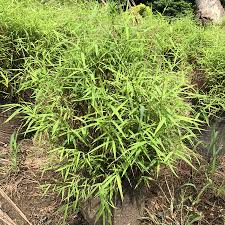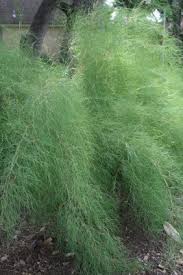Bamboo Grass, scientifically known as Bambusoideae, is a remarkable type of plant that holds great importance in various cultures and ecosystems. With its tall and slender stalks, bamboo grass is often recognized for its strength, flexibility, and rapid growth.
Bamboo grass belongs to the grass family and can be found in different parts of the world, ranging from Asia to the Americas. Its unique structure consists of jointed stems, known as culms, which are hollow and segmented. These segments give bamboo its flexibility while maintaining its strength, making it an ideal material for a wide range of applications.
One of the most intriguing features of bamboo grass is its quick growth rate. Some bamboo species are capable of growing several feet in just a single day! This remarkable growth makes bamboo a sustainable resource for various purposes, including construction, furniture making, and even paper production.
Bamboo grass serves as a crucial part of many ecosystems. It provides habitats for various wildlife, serving as a home for birds, insects, and other animals. Its leaves and stems also contribute to nutrient cycling and soil improvement, benefiting the surrounding environment.
Throughout history, bamboo has played a significant role in various cultures. From being used as a construction material in Asia to being integrated into traditional arts and crafts, bamboo has been an essential part of people’s lives for centuries. Its versatility has led to its incorporation into everyday items like baskets, mats, musical instruments, and even clothing.
In recent years, bamboo has gained attention for its eco-friendly properties. As a fast-growing plant that requires minimal pesticides and fertilizers, it has become a popular choice for sustainable and renewable resources. Bamboo plantations can help reduce deforestation and promote a healthier environment.
In addition, Bamboo Grass (Bambusoideae) stands as a fascinating and valuable plant with its unique characteristics, rapid growth, and widespread use. From its strong yet flexible culms to its ecological and cultural significance, bamboo continues to be a plant that captures the interest and admiration of people around the world.
Read Also: Complete Guide on How to Grow and Care for Mango
Growing and Care Guide of Bamboo Grass

Growing and caring for bamboo grass can be a rewarding experience, whether you’re interested in it as an ornamental plant or for its practical applications. Here’s a simple guide to help you cultivate and maintain bamboo in your garden:
1. Choosing the Right Bamboo:
a. Climate Consideration: Different bamboo species thrive in different climates. Determine whether your climate is suitable for bamboo growth. Some species prefer tropical or subtropical climates, while others can tolerate colder temperatures.
b. Space and Size: Consider the space available in your garden. Bamboo can vary in size, from dwarf varieties that stay under 2-3 feet tall to giant bamboo that can reach over 100 feet. Choose a species that fits your available space.
2. Planting:
a. Soil Preparation: Bamboo prefers well-draining soil that’s slightly acidic. Add compost or organic matter to improve soil structure and fertility.
b. Spacing: Plant bamboo with enough space between each plant to allow for its mature size. Spacing recommendations can vary by species, so research the specific bamboo you’re planting.
c. Planting Depth: Dig a hole slightly larger than the bamboo’s root ball and plant it at the same depth it was in its container. Fill the hole with soil and tamp it down gently.
3. Watering:
a. Establishment: After planting, water the bamboo thoroughly to help it establish its root system. Keep the soil consistently moist but not waterlogged for the first year.
b. Mature Plants: Once established, bamboo is relatively drought-tolerant. However, providing regular water during dry spells can help maintain its health and vigor.
4. Maintenance:
a. Mulching: Apply a layer of organic mulch around the base of the bamboo to retain moisture, suppress weeds, and regulate soil temperature.
b. Fertilization: Bamboo responds well to balanced, slow-release fertilizers. Apply a balanced fertilizer in spring and early summer to promote healthy growth.
c. Pruning: Remove dead or yellowing culms (stems) to encourage new growth. Prune bamboo annually to maintain its appearance and prevent overcrowding.
5. Containment:
a. Rhizome Barrier: Many bamboo species spread through underground rhizomes. To prevent them from spreading uncontrollably, install a rhizome barrier (a sturdy plastic or metal barrier) at least 2 feet deep around the bamboo planting area.
6. Common Issues:
a. Pests and Diseases: While bamboo is generally resistant to pests and diseases, it can sometimes be affected by aphids, mites, or fungal infections. Regular inspection and appropriate treatments, if necessary, can help keep these issues in check.
7. Harvesting and Use:
a. Harvesting: Depending on the species, bamboo can be harvested for various purposes, such as construction, crafts, or even edible shoots. Harvest mature culms carefully, cutting them close to the ground.
Remember that bamboo can be invasive if not properly contained, so research the specific species you’re growing and follow best practices for maintaining its growth within your desired area. With proper care, bamboo grass can thrive and become a beautiful and functional addition to your garden.
Bamboo Muhly Grass

Bamboo Muhly Grass is a charming and unique plant that brings a touch of elegance to gardens and landscapes. With its graceful appearance and easy maintenance, Bamboo Muhly Grass is becoming a popular choice for both amateur gardeners and landscaping professionals.
One of the most striking features of Bamboo Muhly Grass is its appearance. It has slender, bamboo-like stems that can reach up to 4 to 6 feet in height, creating a sense of verticality in the garden. The feathery plumes of the grass are its standout feature, resembling a delicate fountain that sways gracefully with the breeze. These plumes emerge in late summer and last throughout the fall, adding a soft and airy texture to the surroundings.
One of the great benefits of Bamboo Muhly Grass is its adaptability to various environments. It thrives in full sun to partial shade, making it a versatile choice for different areas in the garden. Whether you have a sunny backyard or a shaded corner, Bamboo Muhly Grass can find its place and flourish. Additionally, it is quite drought-tolerant once established, reducing the need for frequent watering.
Maintenance-wise, Bamboo Muhly Grass is relatively low-maintenance, making it an ideal option for those who may not have a lot of time to dedicate to gardening. It requires minimal pruning, usually in late winter or early spring, to remove any dead or damaged stems and encourage new growth. A light trimming can also be done in the late fall to tidy up the appearance of the plant.
Landscapers and garden enthusiasts often use Bamboo Muhly Grass for its versatility. It can be planted as a single specimen for a focal point, or in groups to create a lush and visually appealing border. Its feathery plumes create a sense of movement and softness in the garden, adding a unique visual element that contrasts well with other plants.
In addition, Bamboo Muhly Grass is a wonderful addition to any garden or landscape. Its elegant appearance, adaptability, and low-maintenance nature make it a popular choice for both beginners and experienced gardeners. Whether you’re looking to add height, texture, or a touch of grace to your outdoor space, Bamboo Muhly Grass is sure to captivate with its simple yet stunning beauty.
Read Also: The Origins of the Apple Fruit
Step-by-Step Care Guide of Bamboo Muhly Grass
Here’s a step-by-step care guide for Bamboo Muhly Grass:
Step 1: Choose the Right Location: Select a spot in your garden that receives full sun to partial shade. Make sure the area has well-draining soil to prevent waterlogging, as Bamboo Muhly Grass prefers slightly dry conditions.
Step 2: Planting: Plant your Bamboo Muhly Grass during the spring or fall. Dig a hole that’s slightly larger than the root ball of the plant. Place the plant in the hole and backfill with soil, gently pressing it down around the roots. Water the plant well after planting.
Step 3: Watering: Water the grass regularly during its first growing season to help it establish a strong root system. Once established, Bamboo Muhly Grass is drought-tolerant and requires less frequent watering. Water deeply but infrequently to encourage deep root growth.
Step 4: Pruning: Prune your Bamboo Muhly Grass in late winter or early spring before new growth emerges. Trim away any dead or damaged stems, leaving the healthy ones intact. You can also give the plant a light trimming in the late fall to tidy up its appearance.
Step 5: Fertilizing: Bamboo Muhly Grass doesn’t typically require heavy fertilization. You can apply a balanced, slow-release fertilizer in the spring to give the plant a gentle nutrient boost. Avoid over-fertilizing, as this can lead to excessive foliage growth at the expense of plume production.
Step 6: Mulching: Apply a layer of organic mulch around the base of the plant to help retain moisture, regulate soil temperature, and suppress weed growth. Keep the mulch away from the stems to prevent rot.
Step 7: Pest and Disease Management: Bamboo Muhly Grass is generally resistant to pests and diseases. However, keep an eye out for any signs of aphids or fungal issues. If necessary, treat with appropriate insecticides or fungicides according to the instructions.
Step 8: Winter Care: This grass is hardy in most climates and can survive cold winters. In areas with severe winters, you can leave the dried plumes on the plant over the winter to provide some protection for the crown. If desired, you can trim the plumes in the spring before new growth begins.
Step 9: Division (Optional): After a few years, your Bamboo Muhly Grass may become overcrowded. You can divide the plant to rejuvenate it. Dig up the entire plant, carefully separate the root clumps, and replant the divisions in new locations. Make sure each division has roots and some foliage.
By following these steps, you can ensure the health and vitality of your Bamboo Muhly Grass, allowing it to thrive and bring its graceful beauty to your garden or landscape.
Read Also: Waste-to-Energy Equipment: What You Need To Know
